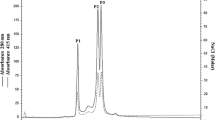Abstract
The monkeys on the island of Sulawesi (Celebes), Indonesia, comprise seven species ofMacaca, that isM. maura, M. tonkeana, M. hecki, M. nigrescens, M. nigra, M. ochreata, andM. brunnescens. Hemoglobins from 248 individuals of these seven species were analyzed by isoelectric focusing electrophoresis (IEFE) and by starch gel electrophoresis in the presence of urea (USGE). Eighteen phenotypes consisting of eight molecular types were identified by IEFE analysis. The speciestonkeana inhabiting the central part of the island revealed 11 phenotypes, while peripheral species such asnigrescens andbrunnescens carried only 3 and 2 phenotypes, respectively.
On USGE, three α chains and three β chains were identified and named α1, α2, and α6, and β1, β3, and β5, respectively. The α1 chain has the same mobility as the α chains of other macaques, while the α2 chain is less positively charged than α1, and α6 is the least positive among these α chains. The α2 chain is widely distributed in the Sulawesi macaques as the major component. Four species,ochreata, tonkeana, maura, andnigrescens, carried the α1 and α6 chains as minor components. The electrophoretic mobility of β1 was the same as that of other macaques, while β3 and β5 were more positively charged and less positively charged than β1, respectively. All of the Sulawesi species had β3 in high or low gene frequencies and inmaura, tonkeana, andbrunnescens, this type was most abundant. β5 chain existed in the species of the northern peninsula, as the major type. The subordinate type was β3 innigra andnigrescens and β1 inhecki. On the other hand, β1 was most frequently observed inochreata.
Similar content being viewed by others

References
Albrecht, G., 1978.The Craniofacial Morphology of the Sulawesi Macaques: Multivariate Approaches to Biological Problems. Contributions to Primatology, Vol. 13, S. Karger, Basel.
Basch, R. S., 1972. Haemoglobin polymorphism in the Rhesus macaque.Nature, 238: 238–240.
Fooden, J., 1969.Taxonomy and Evolution of the Monkeys of the Celebes (Primates: Cercopithecidae). Bibliotheca Primatologica, Vol. 10, S. Karger, Basel.
————, 1976. Provisional classification and key to living species of macaques (Primates:Macaca).Folia Primatol., 25: 225–236.
————, 1982. Ecogeographic segregation of macaques species.Primates, 23: 574–579.
Groves, C. P., 1976. The origin of the mammalian fauna of Sulawesi (Celebes).Sonderdruck aus Z. f. Saugetierkunde Bd., 41: 201–216.
————, 1980. Speciation inMacaca: The view from Sulawesi. In:The Macaques: Studies in Ecology, Behavior, and Evolution,D. G. Lindburg (ed.), Van Nostrand Reinhold, New York pp. 84–124.
Hill, W. C. O., 1974.Primates, Comparative Anatomy and Taxonomy. VII. Cynopithecus (Cercoebus, Macaca, Cynopithecus), Univ. Press, Edinburgh.
Kawamoto, Y., O. Takenaka, &E. Brotoisworo, 1982. Preliminary report on genetic variations within and between species of Sulawesi macaques.Kyoto Univ. Overseas Research Report of Studies on Asian Non-human Primates, 2: 23–37.
Laurie, E. M. O. &J. E. Hill, 1954.List of Land Mammals of New Guinea Celebes and Adjacent Islands, 1758–1952. British Museum, Natural History, London.
Napier, J. R. &P. H. Napier, 1967.A Handbook of Living Primates, Academic Press, London & New York.
Poulik, M. D., 1957. Starch gel electrophoresis in a discontinuous system of buffers.Nature, 180: 1477–1479.
Takenaka, O. &E. Brotoisworo, 1982. Preliminary report on Sulawesi macaques: Their distribution and inter-specific differences.Kyoto Univ. Overseas Research Report of Studies on Asian Non-human Primates, 2: 11–22.
————,A. Takenaka, K. Hayasaka, Y. Kawamoto, T. Shotake, &K. Nozawa, 1985. Hb Izu (Macaca) β83 (EF7) Gly-Cys: The major hemoglobin of the Japanese monkey (Macaca fuscata) in a troop at Shimokita, the northernomst limit of its habitat.Primates, 26: 471–478.
Watanabe, K. &E. Brotoisworo, 1982. Field observation of Sulawesi macaques.Kyoto Univ. Overseas Research Report of Studies on Asian Non-human Primates, 2: 3–9.
Author information
Authors and Affiliations
About this article
Cite this article
Takenaka, O., Hotta, M., Takenaka, A. et al. Origin and evolution of the sulawesi macaques 1. Electrophoretic analysis of hemoglobins. Primates 28, 87–98 (1987). https://doi.org/10.1007/BF02382186
Received:
Accepted:
Issue Date:
DOI: https://doi.org/10.1007/BF02382186



